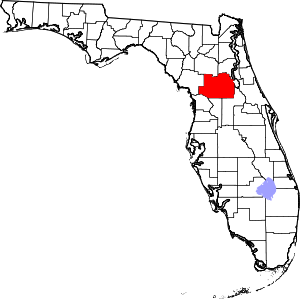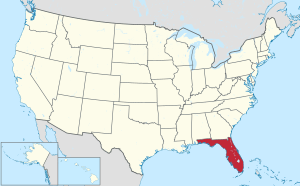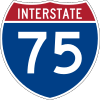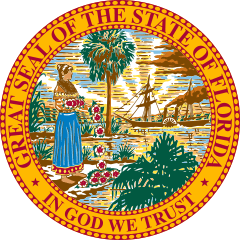Marion County, Florida
Marion County is located in the north central portion of the U.S. state of Florida. As of the 2010 census, the population was 331,298.[2] Its county seat is Ocala.[3]
Marion County | |
|---|---|
County | |
| Marion County | |
Marion County Courthouse in Ocala | |
 Seal | |
 Location within the U.S. state of Florida | |
 Florida's location within the U.S. | |
| Coordinates: 29°13′N 82°04′W | |
| Country | |
| State | |
| Founded | March 14, 1844 |
| Named for | Francis Marion |
| Seat | Ocala |
| Largest city | Ocala |
| Area | |
| • Total | 1,663 sq mi (4,310 km2) |
| • Land | 1,585 sq mi (4,110 km2) |
| • Water | 78 sq mi (200 km2) 4.7%% |
| Population | |
| • Estimate (2019) | 365,579[1] |
| • Density | 224/sq mi (86/km2) |
| Time zone | UTC−5 (Eastern) |
| • Summer (DST) | UTC−4 (EDT) |
| Congressional districts | 2nd, 3rd, 11th |
| Website | www |
Marion County comprises the Ocala, FL Metropolitan Statistical Area. it includes part of Ocala National Forest, which also extends into three other counties.
History
Native Americans
Evidence of ancient indigenous cultures has been found in Marion County, as well as of the earliest encounter between European explorers and historic indigenous peoples. In 1976, an archaeological investigation found ancient artifacts in Marion County that appear to be the oldest in mainland United States. Excavations at an ancient stone quarry (on the Container Corporation of America site (8Mf154) in Marion County) yielded "crude stone implements". Thousands of pieces of chert were found at the site. These showed signs of extensive wear and were found in deposits below those holding Paleo-Indian artifacts. Thermoluminescence dating and weathering analysis independently gave dates of 26,000 to 28,000 Years Before Present (YBP) for the production of these artifacts, prior to Clovis points. The findings suggested human habitation in this area much earlier than documented by other evidence.[4] Barbara Purdy had bipoint evidence from the CCA site, which also predated Clovis points, which she reported in a 2008 paper.[5]
The county seat of Ocala, Florida is named for a Timucuan village visited and recorded by the Spanish Hernando de Soto expedition in the sixteenth century. During the colonial period, Spain and Great Britain traded control of this area.
Settlement
After acquisition of the Florida territory by the United States in the 1820s, Marion County was created in 1844 from portions of Alachua, Mosquito (Orange), and Hillsborough counties. Until 1853, Marion County included most of what are now Lake and Sumter counties. In 1849, Putnam County was created and took the northeast portion of Marion. Levy County’s creation took some of the western portion of Marion in 1877, near the end of the Reconstruction era.
Marion County is named after General Francis Marion of South Carolina, a guerrilla fighter and hero of the American Revolutionary War who was known as the "Swamp Fox".[6] Numerous early settlers of this area were natives of South Carolina and likely picked their local hero as the county's namesake.[7] The Act creating the county of Marion of the Territory of Florida was signed on March 14, 1844, by the territorial governor, R. K. Call. The county motto is "Kingdom of the Sun."
Civil War Era
Marion County was a hotbed of secessionist activity. Organizers petitioned the state to host the Florida Secession Convention and break away from the United States with other Southern states.[8] The area had many plantations and more than half of the population was enslaved African Americans.
Several Confederate Army units were organized by white planters, including the Marion Rifle Guards, organized May 2, 1861 by Captain W.L. Fletcher, county treasurer. It served as part of the Fourth Florida Infantry under Col. Edward Hopkins. Other company's included the Hammock Guards, commanded by Captain J.S. Hopkins; Marion Dragoons, a cavalry unit organized and financed by William A. Owens; and Marion Hornets, commanded by Captain Wade Eichelberger.[8] The Civil War and its aftermath disrupted local society and strained the economy. The population declined in its wake as many African Americans moved to towns or cities for better opportunities.
Post-Reconstruction era to mid-20th century
During the post-Reconstruction period, there was considerable racial violence by whites against blacks in Marion County. They used terrorism to re-establish and maintain white supremacy and suppress black voting before disenfranchising most blacks around the turn of the 20th century. Whites lynched between 19 and 26 African Americans in the county from the 1880s to 1935.[9]
Mid-20th century to present
Since the mid-20th century, thoroughbred horse farms have been established in the county. Such thoroughbred farms have become known for such race champions as Needles, bred at Bonnie Heath Farm, and in 1956 becoming the first Florida-bred horse to win the Kentucky Derby. In 1978 Affirmed from Harbor View Farm won the Triple Crown.
Carl G. Rose, who had come to Florida in 1916 from Indiana to oversee construction of the first asphalt road in the state, is credited with developing the first thoroughbred horse farm in 1943. As an engineer, he had become familiar with the area's limestone, which he realized supported good pasture for raising strong horses. (Limestone also nurtures central Kentucky's noted Bluegrass Region.) In 1943, Rose bought land along State Highway 200, at $10 per acre, establishing Rosemere Farm. The next year one of his horses, Gornil, won at Miami's Tropical Park, becoming the first Florida-raised thoroughbred to win a Florida race. This raised the profile of Marion County in the racing world. Rosemere Farm was sold long ago. The large site was redeveloped for the retail center Paddock Mall and the College of Central Florida.
Close on Rose's heels, entrepreneur Bonnie Heath set up his own thoroughbred farm, producing Needles. In 1956 the horse was the state's first native-bred winner of the Kentucky Derby. (see further below). Bonnie Heath Farm is owned and operated by Bonnie Heath III and his wife Kim.
In 1978, Marion County-bred-and-raised Affirmed won the Triple Crown. Today, Marion County is a major world thoroughbred center with more than 1200 horse farms. There are about 900 thoroughbred farms, totaling some 77,000 acres (310 km2). Ocala is well known as a "horse capital of the world."[10]
Tourism
The nearby community of Silver Springs developed around the Silver Springs, a group of artesian springs on the Silver River. In the 19th century, this site became Florida's first tourist destination.
Today, well known for glass-bottom boat tours of the area, Silver Springs is owned by the State of Florida; it was incorporated into Silver Springs State Park in 2013.[11][12] Other nearby natural attractions include the Ocala National Forest and the Florida Trail. Several prominent man-made attractions in the Ocala area existed in the past, such as the Western-themed Six Gun Territory theme park (operated from 1963 to 1984) and the Wild Waters water park (operated from 1978 to 2016).
Geography
According to the U.S. Census Bureau, the county has a total area of 1,663 square miles (4,310 km2), of which 1,585 square miles (4,110 km2) is land and 78 square miles (200 km2) (4.7%) is water.[13]
Marion County is generally composed of rolling hills, much like most of the rest of Florida. The majority of its trees consist of live oaks, pines, and palm trees. Marion County is considered the southernmost county in North Central Florida, and the northernmost county in Central Florida.
It is about a two-hour drive from Marion County to many of Florida's major cities; Orlando is 75 minutes to the southeast, while Daytona Beach is about 90 minutes to the east. Tampa is about 75 minutes to the southwest, Jacksonville is roughly a two-hour drive northeast, and Miami is about six hours to the southeast.
There are several significant lakes within or bordering Marion County. Orange Lake is in the far northern part of Marion County, near the border with Alachua County. Lake Kerr is in the northeastern part of the county, near the town of Salt Springs, which is near the border with Putnam County. Lake Weir, the largest of the three, is in the far southern region near the border with Lake County. Part of Lake George is also in Marion County.
Marion County is inland, centered between the Atlantic Ocean to the east and the Gulf of Mexico to the west. Because of this, the area is generally not affected as much by hurricanes as the more coastal counties to its east and west. The largest threats from natural disasters are high winds and flooding; tornadoes are also concern.
Adjacent counties
- Putnam County, Florida – northeast
- Volusia County, Florida – east
- Lake County, Florida – southeast
- Sumter County, Florida – south
- Citrus County, Florida – southwest
- Levy County, Florida – west
- Alachua County, Florida – northwest
National protected area
- Ocala National Forest (part)
Demographics
| Historical population | |||
|---|---|---|---|
| Census | Pop. | %± | |
| 1850 | 3,338 | — | |
| 1860 | 8,609 | 157.9% | |
| 1870 | 10,804 | 25.5% | |
| 1880 | 13,046 | 20.8% | |
| 1890 | 20,796 | 59.4% | |
| 1900 | 24,403 | 17.3% | |
| 1910 | 26,941 | 10.4% | |
| 1920 | 23,968 | −11.0% | |
| 1930 | 29,578 | 23.4% | |
| 1940 | 31,243 | 5.6% | |
| 1950 | 38,187 | 22.2% | |
| 1960 | 51,616 | 35.2% | |
| 1970 | 69,030 | 33.7% | |
| 1980 | 122,488 | 77.4% | |
| 1990 | 194,833 | 59.1% | |
| 2000 | 258,916 | 32.9% | |
| 2010 | 331,298 | 28.0% | |
| Est. 2019 | 365,579 | [14] | 10.3% |
| U.S. Decennial Census[15] 1790-1960[16] 1900-1990[17] 1990-2000[18] 2010-2019[2] | |||
As of the census[19] of 2000, there were 258,916 people, 106,755 households, and 74,621 families residing in the county. The population density was 164 people per square mile (63/km2). There were 122,663 housing units at an average density of 78 per square mile (30/km2). The racial makeup of the county was 84.16% White, 11.55% Black or African American, 0.45% Native American, 0.70% Asian, 0.02% Pacific Islander, 1.69% from other races, and 1.44% from two or more races. 6.03% of the population were Hispanic or Latino of any race. According to the 2000 Census the largest European ancestry groups in Marion County were English (18.7%), German (16.7%) and Irish (14.0%).
There were 106,755 households, out of which 24.70% had children under the age of 18 living with them, 55.60% were married couples living together, 10.70% had a female householder with no husband present, and 30.10% were non-families. 25.00% of all households were made up of individuals, and 13.00% had someone living alone who was 65 years of age or older. The average household size was 2.36 and the average family size was 2.79.
In the county, the population was spread out, with 21.40% under the age of 18, 6.40% from 18 to 24, 23.80% from 25 to 44, 23.90% from 45 to 64, and 24.50% who were 65 years of age or older. The median age was 44 years. For every 100 females there were 93.30 males. For every 100 females age 18 and over, there were 89.90 males.
The median income for a household in the county was $31,944, and the median income for a family was $37,473. Males had a median income of $28,836 versus $21,855 for females. The per capita income for the county was $17,848. About 9.20% of families and 13.10% of the population were below the poverty line, including 20.20% of those under age 18 and 7.40% of those age 65 or over.
Government and infrastructure
The county is governed by the Marion County Board of County Commissioners.[20] Kathy Bryant is the Chair of the five-person board.
The Florida Department of Corrections operates facilities in unincorporated areas in the county, including the Lowell Correctional Institution, and the Lowell Annex[21][22] which houses Florida's female death row.[23]
| Year | Republican | Democratic | Other |
|---|---|---|---|
| 2016 | 61.30% 107,833 | 35.27% 62,041 | 3.43% 6,026 |
| 2012 | 57.53% 93,043 | 41.32% 66,831 | 1.15% 1,864 |
| 2008 | 55.14% 89,628 | 43.58% 70,839 | 1.28% 2,075 |
| 2004 | 58.19% 81,283 | 41.00% 57,271 | 0.80% 1,123 |
| 2000 | 53.55% 55,146 | 43.39% 44,674 | 3.06% 3,151 |
| 1996 | 45.92% 41,409 | 41.08% 37,045 | 13.00% 11,717 |
| 1992 | 40.74% 35,442 | 35.44% 30,829 | 23.82% 20,718 |
| 1988 | 66.38% 41,501 | 33.09% 20,685 | 0.53% 334 |
| 1984 | 69.97% 37,815 | 30.02% 16,225 | 0.01% 6 |
| 1980 | 58.49% 23,743 | 37.94% 15,400 | 3.57% 1,449 |
| 1976 | 47.99% 16,163 | 50.37% 16,963 | 1.64% 553 |
| 1972 | 78.18% 19,505 | 21.63% 5,397 | 0.18% 46 |
| 1968 | 32.66% 7,468 | 25.36% 5,798 | 41.98% 9,600 |
| 1964 | 54.42% 10,879 | 45.58% 9,112 | |
| 1960 | 49.43% 7,043 | 50.57% 7,206 | |
| 1956 | 50.99% 6,362 | 49.01% 6,114 | |
| 1952 | 51.17% 6,134 | 48.83% 5,854 | |
| 1948 | 22.43% 1,829 | 57.01% 4,650 | 20.56% 1,677 |
| 1944 | 22.68% 1,642 | 77.32% 5,597 | |
| 1940 | 17.47% 1,297 | 82.53% 6,127 | |
| 1936 | 14.01% 760 | 85.99% 4,664 | |
| 1932 | 23.07% 962 | 76.93% 3,208 | |
| 1928 | 49.75% 1,927 | 48.10% 1,863 | 2.14% 83 |
| 1924 | 17.25% 359 | 73.43% 1,528 | 9.33% 194 |
| 1920 | 31.57% 1,232 | 62.43% 2,436 | 6.00% 234 |
| 1916 | 19.50% 462 | 66.15% 1,567 | 14.35% 340 |
| 1912 | 10.87% 179 | 70.73% 1,165 | 18.39% 303 |
| 1908 | 22.05% 482 | 61.85% 1,352 | 16.10% 352 |
| 1904 | 15.84% 230 | 75.14% 1,091 | 9.02% 131 |
Law enforcement
- Marion County Sheriff's Office[25]
- Belleview Police Departments[26]
- Dunnellon Police Departments[27]
- Ocala Police Departments[28]
Marion County's police force were in the news in August 2020 during the COVID-19 pandemic in Florida after Sheriff Billy Woods forbade the wearing of masks by deputies or visitors to the police station.[29][30]
Education
County public education is supervised under the Marion County School District.
Public school system
- 28 elementary schools
- 8 middle schools
- 1 4-8 school
- 1 K-8 center
- 10 high schools
- 3 charter schools
- 14 special needs schools
Elementary schools
- Anthony Elementary School
- Belleview Elementary School
- Belleview-Santos Elementary School
- College Park Elementary School
- Dr. N.H. Jones Elementary (magnet)
- Dunnellon Elementary School
- East Marion Elementary School
- Eighth Street Elementary School
- Emerald Shores Elementary School
- Evergreen Elementary School
- Fessenden Elementary School
- Fort McCoy School (K-8)
- Greenway Elementary School
- Hammett Bowen Jr. Elementary School
- Harbour View Elementary School
- Horizon Academy at Marion Oaks (grades 5-8)
- Katie Fay Elementary School
- Legacy Elementary School
- Madison Street Academy of Visual and Performing Arts (magnet)
- Maplewood Elementary School
- Oakcrest Elementary School
- Ocala Springs Elementary School
- Reddick-Collier Elementary School
- Romeo Elementary School
- Saddlewood Elementary School
- Shady Hill Elementary School
- South Ocala Elementary School
- Sparr Elementary School
- Stanton-Weirsdale Elementary School
- Sunrise Elementary School
- Ward-Highlands Elementary School
- Wyomina Park Elementary School
Middle schools
- Belleview Middle School
- Dunnellon Middle School
- Fort King Middle School
- Fort McCoy School (K-8)
- Horizon Academy at Marion Oaks (grades 4-8)
- Howard Middle School
- Lake Weir Middle School
- Liberty Middle School
- North Marion Middle School
- Osceola Middle School
High schools
Private schools
- Ambleside School Of Ocala, grades K-8[31]
- Belleview Christian Academy, grades PK-9
- Blessed Trinity School, grades K-9
- Children's Palace East & Academy, grades K-2
- The Cornerstone School, grades PK-8[32]
- Crossroads Academy, grades 3-12
- Grace Building Blocks School, grades K-2
- Grace Christian School, grades PK-8
- Meadowbrook Academy, grades K-12[33]
- Montessori Preparatory School, grades K-5
- New Generation School, grades K-12
- Ocala Christian Academy, grades PK-12[34]
- Ocean's High School, grades PK-12
- Promiseland Academy, grades K-7
- First Assembly Christian School, grades PK-12[35]
- The Reading Clinic, grades 2-6
- Redeemer Christian School, grades K-9
- The Rock Academy, grades PK-9
- The School of the Kingdom, grades 1-12
- Shiloh SDA Church School[36]
- St John Lutheran School, grades PK-12
- Trinity Catholic, grades 9-12
Libraries
The Marion County Public Library System operates eight branch libraries.
Transportation
Interstates and expressways

Surface roads












Railroads
CSX operates one rail line within the county. Amtrak formerly provided passenger rail service to Ocala Union Station, but the stop was terminated in late 2004.[38] The line is a former Seaboard Airline Railroad line known as the Wildwood Subdivision, and is part of the CSX-S Line.
Nearby that line within Ocala is a former line owned by the Florida Northern Railroad, which was previously owned by the Atlantic Coast Line Railroad. It begins in Candler running northwest along Marion County Road 464 towards Ocala Union Station then continues northwest along Marion County 25A to Lowell.
Another FNOR rail line includes a freight line to the Crystal River Energy Complex in northern Citrus County, which was previously owned by the Atlantic Coast Line Railroad. It runs primarily along US 41 between the Citrus and Levy County Lines. Other lines that used to run through Marion County were either converted into rail trails or abandoned.
Politics
| Year | Republican | Democratic |
|---|---|---|
| 2016 | 61.3% 107,833 | 35.3% 62,041 |
| 2012 | 57.5% 93,043 | 41.3% 66,831 |
| 2008 | 55.1% 89,628 | 43.6% 70,839 |
| 2004 | 58.2% 81,283 | 41.0% 57,271 |
| 2000 | 55.6% 55,146 | 43.4% 44,674 |
| 1996 | 45.9% 41,409 | 41.1% 37,045 |
| 1992 | 40.5% 35,442 | 35.4% 30,829 |
| 1988 | 66.4% 41,501 | 33.1% 20,685 |
| 1984 | 70.0% 37,815 | 30.0% 16,225 |
| 1980 | 58.5% 23,743 | 37.9% 15,400 |
| 1976 | 48.0% 16,163 | 50.4% 16,963 |
| 1972 | 78.2% 19,505 | 21.6% 5,397 |
| 1968 | 32.7% 7,468 | 25.4% 5,798 |
| 1964 | 54.4% 10,879 | 45.6% 9,112 |
| 1960 | 49.4% 7,043 | 50.6% 7,206 |
Marion County has become a solidly Republican county since 1980.
Communities
Census-designated places
- Silver Springs Shores
- The Villages (with Lake and Sumter Counties)
Other unincorporated communities
- Anthony
- Citra
- Early Bird
- Evinston, partly in Alachua County
- Fort McCoy
- Flemington
- Marion Oaks
- Ocklawaha
- Orange Lake
- Orange Springs
- Rainbow Lakes Estates
- Salt Springs
- Shiloh[41]
- Summerfield
- Wacahoota, partly in Alachua County and Levy County.
- Woods and Lakes, Florida[42]
See also
References
- https://www.census.gov/quickfacts/fact/table/marioncountyflorida/PST045217
- "State & County QuickFacts". United States Census Bureau. Archived from the original on June 25, 2011. Retrieved June 15, 2014.
- "Find a County". National Association of Counties. Retrieved June 7, 2011.
- Barbara A. Purdy, "Investigations into the Use of Chert Outcrops by Prehistoric Floridians: The Container Corporation of America Site", Florida Anthropologist, Vol. 34, No. 2, June 1981, pp. 90-
- Wm Jack Hranicky, Bipoints Before Clovis: Trans-Oceanic Migrations and Settlement of Prehistoric Americas, Universal-Publishers, 2012, p. 225
- Publications of the Florida Historical Society. Florida Historical Society. 1908. p. 33.
- Pyle, Nancy (May 14, 1987). "County's history reflected in its names". Ocala Star-Banner. pp. 8A. Retrieved May 30, 2015.
- https://www.ocala.com/news/20080425/the-civil-war-years
- Medina, Carlos E. (January 25, 2019). "Marion County, like other communities, addresses its history of lynchings". Ocala.com. Retrieved March 21, 2020.
- "The Horse Capital of the World". Ocalacc.com. Archived from the original on September 25, 2012. Retrieved January 11, 2013.
- Thompson, Bill. "State lets Palace Entertainment out of Silver Springs lease". Ocala.com. Retrieved December 17, 2015.
- Stone, Rick (January 24, 2013). "Silver Springs, Oldest Florida Tourist Attraction, Will Become A State Park". wlrn.com. WLRN. Retrieved April 8, 2014.
- "US Gazetteer files: 2010, 2000, and 1990". United States Census Bureau. February 12, 2011. Retrieved April 23, 2011.
- "Population and Housing Unit Estimates". Retrieved March 26, 2020.
- "U.S. Decennial Census". United States Census Bureau. Retrieved June 15, 2014.
- "Historical Census Browser". University of Virginia Library. Retrieved June 15, 2014.
- "Population of Counties by Decennial Census: 1900 to 1990". United States Census Bureau. Retrieved June 15, 2014.
- "Census 2000 PHC-T-4. Ranking Tables for Counties: 1990 and 2000" (PDF). United States Census Bureau. Retrieved June 15, 2014.
- "U.S. Census website". United States Census Bureau. Retrieved May 14, 2011.
- Board of County Commissioners. Accessed August 11, 2020.
- "Lowell Correctional Institution Archived February 28, 2014, at the Wayback Machine." Florida Department of Corrections. Retrieved on August 31, 2010.
- "Lowell Annex Archived August 18, 2010, at the Wayback Machine." Florida Department of Corrections. Retrieved on August 31, 2010.
- "Death Row Fact Sheet Archived August 3, 2010, at the Wayback Machine." Florida Department of Corrections. Retrieved on August 15, 2010.
- Leip, David. "Dave Leip's Atlas of U.S. Presidential Elections". uselectionatlas.org. Retrieved June 15, 2018.
- Marion County Sheriff's Office
- Belleview Police Departments
- Dunnellon Police Departments
- Ocala Police Departments
- 'This is no longer a debate': Florida sheriff bans deputies, visitors from wearing masks
- Marion County deputies ordered not to wear masks
- "A living education". Amblesideocala.com. Archived from the original on December 14, 2015. Retrieved December 17, 2015.
- "Home". Thecornerstoneschool.org. December 8, 2015. Retrieved December 17, 2015.
- "Meadowbrook Academy : Home". Mbaocala.org. Retrieved December 17, 2015.
- "Home — Ocala Christian Academy". Ocacrusaders.com. Retrieved December 17, 2015.
- "Ocala First Assembly of God — An A/G Church in North Central Florida — Ocala, FL". Ocalafirst.org. Retrieved December 17, 2015.
- "Shiloh SDA Church School : Home". Antt40.adventistschoolconnect.org. Retrieved December 17, 2015.
- Marion County Airport
- "St. Petersburg Times". Loss of Amtrak service shouldn't derail Dade City. Retrieved October 29, 2004.
- "Archived copy". Archived from the original on June 13, 2010. Retrieved November 26, 2013.CS1 maint: archived copy as title (link)
- http://uselectionatlas.org/RESULTS/
- Carro, Susan Latham (August 1, 2006). "Rural Shiloh Country may give way to development". Gainesville Sun. Retrieved July 7, 2019.
- "AirNav: FA38 - Woods and Lakes Airpark". www.airnav.com. Retrieved May 25, 2019.
External links
| Wikimedia Commons has media related to Marion County, Florida. |

